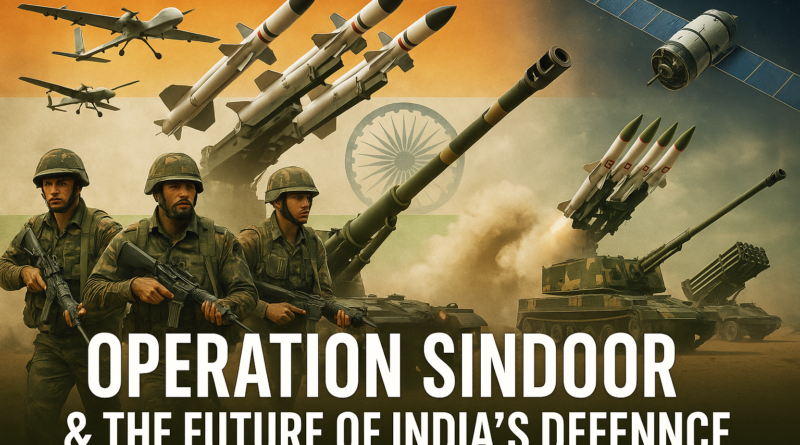Operation Sindoor and the Future of India’s Defence Sector
A Strong Response to Terror
A terrorist attack struck Pahalgam on April 22, 2025, allegedly orchestrated by Pakistan-based elements. In swift retaliation, India launched Operation Sindoor on May 7, 2025. This high-precision mission targeted cross-border terrorist infrastructure and demonstrated India’s resolve to combat terrorism with strategic intensity.
The operation involved coordinated efforts by the Indian Army and intelligence agencies. It successfully neutralized nine terrorist camps across Pakistan and Pakistan-occupied Kashmir (PoK), eliminating a significant number of terrorists. Defence Minister Rajnath Singh emphasized that such operations highlight the importance of upholding high standards in national security.
Key systems deployed included the Swathi Weapon Locating Radar, Bofors and Dhanush howitzers, and Pinaka rocket launchers for counter-artillery roles. The operation also leveraged BMP-2 vehicles, Akash air defence systems, and advanced UAVs for surveillance and target acquisition.
Space and Satellite Defence: The New Frontier
India is reinforcing its defence capabilities in space with a planned 52-satellite constellation and a dedicated military space doctrine. This strategic evolution recognizes space as a vital warfighting domain, alongside land, sea, air, and cyber.
While ISRO’s primary role lies in space exploration and scientific innovation, it also supports national defence through:
- Military communication satellites such as GSAT-7, 7A, and 7B, facilitating encrypted communication across the Army, Navy, and Air Force.
- EMISAT and RISAT satellites for real-time surveillance and signal intelligence.
- CARTOSAT satellites offering high-resolution border imagery for tracking hostile movements.
India’s Defence Support Program (DSP) mirrors global best practices, reinforcing deterrence and situational awareness. With the Make in India and Atmanirbhar Bharat initiatives in full swing, the space-defence synergy is enabling India to pursue technological sovereignty.
Growth Trajectory of India’s Defence Market
India’s defence budget for FY 2025-26 stands at ₹6.81 lakh crore, a 9.5% increase from the previous year. The capital outlay of ₹1.80 lakh crore prioritizes military modernization, while ₹4.7 lakh crore covers salaries and pensions—highlighting the human capital at the core of India’s defence forces.
Key indicators of India’s growing defence stature:
- DRDO receives ₹26,816.82 crore (12.4% hike) for R\&D.
- India ranks 4th in global air power with 2,296 military aircraft.
- Defence exports hit a record ₹23,622 crore in FY 2024-25, up by 12% from the previous year.
Private players like Tata, L\&T, Zen Technologies, and Garuda Aerospace are making major strides in defence manufacturing. Drone technologies are expanding rapidly, with firms like Asteria Aerospace, Throttle Aerospace, and Paras Aerospace catering to both civil and military clients.
Stock markets are also responding positively—companies like Paras Defence, Mazagon Dock, Garden Reach, HAL, and Bharat Dynamics have seen impressive returns amid rising orders and policy support.
Government-Led Defence Reforms and Strategic Push
Under Prime Minister Modi’s leadership, defence indigenization has become a national priority. Defence Minister Rajnath Singh stressed the importance of shifting from import dependency to self-reliance.
Key initiatives include:
- Corporatization of ordnance factories to enhance efficiency and output.
- Uttar Pradesh is emerging as a defence hub, home to 7 ordnance factories, 3 HAL units, the AK-203 rifle plant in Amethi, and the BrahMos facility in Lucknow.
- Two Defence Industrial Corridors (DICs) in UP and Tamil Nadu are attracting significant investment from private and global players.
- The PLI Scheme and iDEX program are nurturing defence startups and spurring innovation.
India now exports to over 80 countries, including the Philippines, Vietnam, Armenia, and several African nations. Major export items include BrahMos missiles, radars, patrol vessels, and rocket launchers.
Future Outlook: Tech-Driven Defence Leadership
India aims to reach ₹50,000 crore in defence exports by 2029, and potentially ₹2.8 lakh crore by 2047. A strategic pivot is underway, reducing reliance on Russia and deepening ties with the U.S., France, and other Western partners.
Emerging technologies are reshaping the battlefield:
- Quantum technologies (secure communications and sensing)
- AI-powered defence systems
- Directed energy weapons (lasers and microwave-based systems)
- Swarm drones and cyber warfare
- 3D printing and human performance enhancement
The DIA’s 2025 assessment underlines the urgency of integrating quantum readiness into national defence strategies, given the aggressive pursuit of such technologies by countries like China and Russia.
India’s own R\&D pipeline is active with projects like:
- Project Kusha – the Extended Range Air Defence System (ERADS) expected by 2028-29.
- Project Varsha – an advanced submarine base at Rambilli.
- Project-75 – construction of six Kalvari-class submarines based on the French Scorpene design.
Conclusion: A Decade of Transformation
India’s defence sector is on the cusp of a historic transformation. Through policy innovation, public-private collaboration, and adoption of next-gen technologies, India is securing its place as a global defence manufacturing hub.
With initiatives like Make in India, Atmanirbhar Bharat, and the Agniveer program, the government is not only strengthening national security but also fostering economic growth, technological innovation, and strategic autonomy.
India’s defence story is no longer just about safeguarding borders—it’s about leading on the world stage.
For more such interesting blogs, please visit: https://vichaardhara.co.in/


